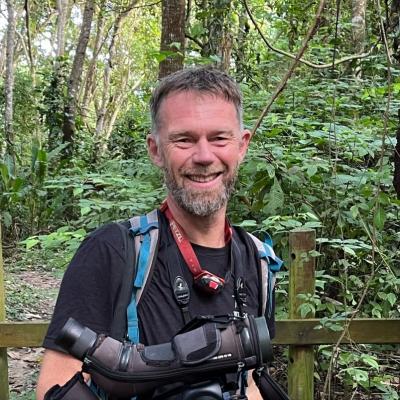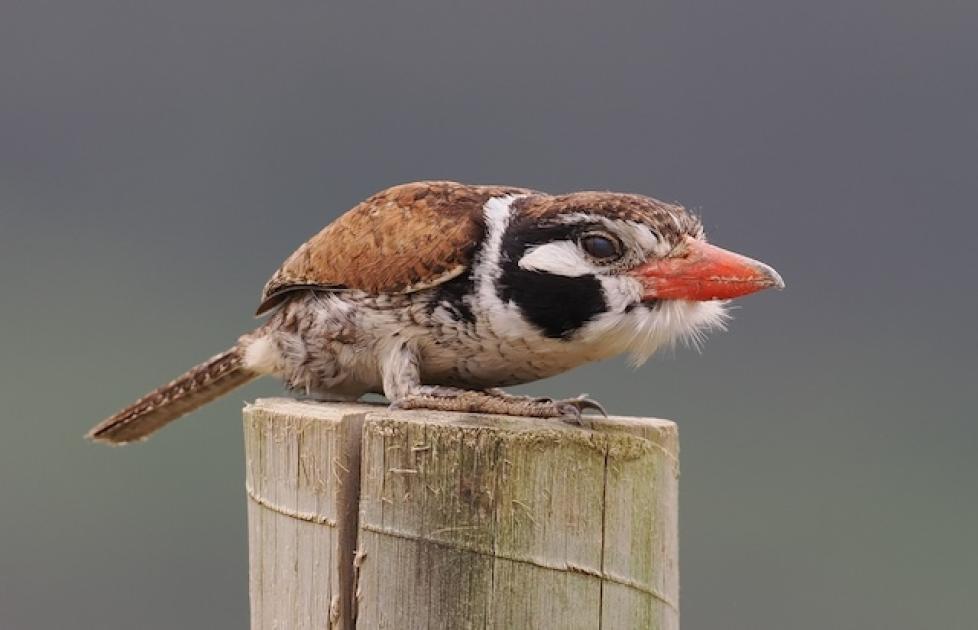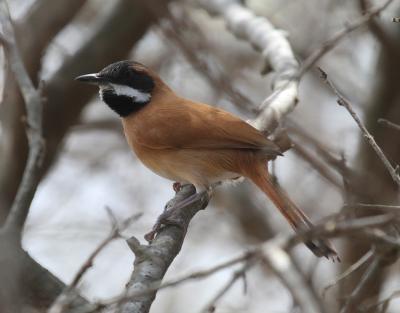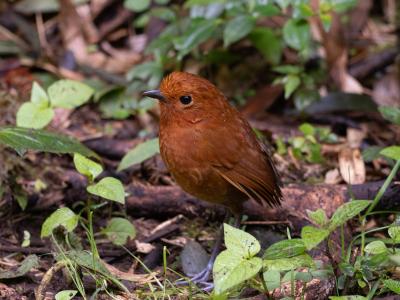Brazil: Minas Gerais
-
Oct 19-28, 2026
Fabrice Schmitt
Tour Price to be Determined
Tour Price to be Determined
The state of Minas Gerais in the heart of Brazil’s cerrado biome offers wonderful birding and wildlife viewing. We’ll visit well-known protected areas such as Serra da Canastra National Park, Caraça Sanctuary, and Serra do Cipo where the birding will be amazing. We’ll have a great chance of seeing the extremely endangered Brazilian Merganser, the stunning Swallow-tailed Cotinga and Helmeted Manakin, the cute Cock-tailed Tyrant and Gray-backed Tachuri, and superb hummingbirds such as Hyacinth Visorbearer and Horned Sungem, among many others. In addition we can almost guarantee the charismatic Giant Anteater in the Serra da Canastra and Maned Wolf at a feeding station at Caraça.
Because we are visiting mostly open to semi-open habitats, the birding is very easy and memorable with a number of range restricted and cerrado specialties.
Note: In 2025 it’s possible to do this tour back to back with Brazil: The Northeast - Bahia the Beautiful. There is a day between tours that isn't included in the tour price.
In 2026 it’s possible to run this tour back to back with Brazil: The Southeast Atlantic Rainforest.
Day 1: The tour begins at 6 pm in the lobby of our hotel, near Belo Horizonte International Airport. Night in Belo Horizonte.
Day 2: This is a long traveling day as we drive through Belo Horizonte, cross the busy city, and make our way west to Serra da Canastra National Park. We may have time to check the shore of a lake as we pass through the city, where we have chance to find a few waterbirds including the rare Southern Pochard. The total time of the drive is approximately six hours, and because we want to arrive early enough to do some birding there, we’ll only stop for lunch…and for stunning birds such as Toco Toucan or Red-legged Seriema. Night in São Roque de Minas.
Days 3-5: We’ll have three full days to explore the surroundings of São Roque and the various elevations of Serra da Canastra National Park. We’ll spend one day on the top of the Canastra plateau, where the habitat is a mix of savanna grassland and a few patches of gallery forest. In the grassland we’ll be looking for the superb Cock-tailed Tyrant, Red-winged Tinamou, Sharp-tailed Tyrant, Ochre-breasted Pipit, Wedge-tailed Grass-Finch, Stripe-tailed Yellow-Finch, the uncommon but stunning Black-masked Finch, and the super cute Gray-backed Tachuri, one of numerous Brazilian endemics we’ll see on the tour. The savanna is dotted with gray and red termite nests, on top of which are often perched photogenic Peach-fronted Parakeets. These termite nests also attract the bizarre Giant Anteater (which mostly feeds on termites), and we’ll have a good chance of spotting one, as Canastra is probably the best place in the world to see this magnificent creature.
The gallery forest will offer a completely different set of birds, such as the secretive Brasilia Tapaculo, the vocal White-rumped Tanager, Rufous-winged Antshrike, and the secretive and handsome Sharp-tailed Streamcreeper. We’ll have our lunch at the upper part of the “Tapir waterfall,” where the São Francisco River drops from the plateau to the lower part of the National Park. The scenery is stunning, and in the shrubbery near our picnic spot we have a chance of seeing Black-throated Saltator, White-vented Violetear, White-rumped Monjita, Crested Black-Tyrant, Cinnamon Tanager, and Plain-crested Elaenia, among many others. We’ll stay as late as possible on the plateau since Giant Anteater are usually more active late in the day.
On another day we’ll visit the lowest part of the park, at the base of the plateau. We’ll bird along the São Francisco River, looking for the extremely rare and critically endangered Brazilian Merganser, a species that requires very high-quality water and has disappeared from most of Brazil. In the forest along the river, we’ll find superb birds such as Helmeted Manakin, Red-breasted and Toco Toucans, Curl-crested Jay, Pileated Finch, White-shouldered Fire-eye, Rufous-tailed Jacamar, and Ruby-crowned Tanager. We’ll also visit a small marsh where the gorgeous Streamer-tailed Tyrant, one of the most beautiful tyrant-flycatchers, breeds, and we might also find Yellow-rumped Marshbird, Chestnut-capped Blackbird, Rufous-sided Crake, Gray-cowled Wood-Rail, Masked Water-Tyrant, Sooty Tyrannulet, and even Aplomado Falcon.
We’ll spend our last day at the upper or lower part of the park, depending on which birds we may not have seen yet, or just want to see again. Nights in São Roque.
Day 6: After some morning birding on a road near our hotel, we’ll spend the rest of the day driving to Caraça. Caraça is unique. Created in 1774, the Caraça Sanctuary was first intended as a religious center and it is still an important place for pilgrims. The sanctuary and monastery are now open to public and the extensive trail system is wonderful for birding. The monastery is also famous for the Maned Wolves that come every night to a feeding station, just a few meters from visitors. We’ll be staying three nights in the monastery, giving us a good chance to see the wolves but also to absorb this beautiful and peaceful place. Night in Caraça.
Days 7-8: We’ll have two full days to explore the extensive trail system at Caraça. The birding here is usually excellent, and the list of range-restricted species seems endless: Hyacinth Visorbearer, Pale-throated Pampa-Finch, Serra Antwren, Hangnest Tody-Tyrant, Rock Tapaculo, and on and on. Mixed-species flocks usually include Brassy-breasted, Gilt-edged, Golden-chevroned, and Black-goggled Tanagers, while in the understory we may find White-shouldered Fire-eye, Dusky-tailed and Ochre-rumped Antbirds, Buff-browed Foliage-gleaner, and Rufous-capped Spinetail sometimes foraging together. Rufous Gnateater is common, though difficult to see, as is the smart Drab-breasted Tody-Tyrant. There are several leks of the stunning Swallow-tailed Manakin, and we may also find the elegant Pin-tailed Manakin. A small pond near the monastery usually attracts Slaty-breasted Wood-Rail and Blackish Rail, and Orange-eyed Thornbird is sometimes nesting nearby. Among the other birds we’ll be looking for are White-bibbed Antbird, Large-tailed Antshrike, and the rare Swallow-tailed Cotinga. During our walks we also have a good chance of finding a group of Black-fronted Titi Monkeys, and in the evening we’ll wait for the famous Maned Wolves. Every night, in a custom started decades ago, food is left at the entrance of the church, and every night the wolves come. It’s an utterly memorable part of the tour. Nights in Caraça.
Day 9: After some morning birding near our lodging, we’ll have depart for the Serra do Cipó. We’ll bird the spectacular and isolated mountain where there are plenty of attractive birds, including Blue Finch (a really pretty one!), Horned Sungem, White Woodpecker, Gray-backed Tachuri, White-eared Puffbird and other specialties of the specific campo rupestre habitat of the cerrado biome. Even the rare Cinereous Warbling-Finch can be seen here. Night in the Serra do Cipó.
Day 10: After all morning birding around Cipó looking for the regional specialties, we’ll have lunch in town and then return to the Belo Horizonte airport, where the tour concludes about 3 p.m.
Note: The information presented here is an abbreviated version of our formal General Information for Tours to Brazil. Its purpose is solely to give readers a sense of what might be involved if they take this tour. Although we do our best to make sure that what follows here is completely accurate, it should not be used as a replacement for the formal document which will be sent to all tour registrants, and whose contents supersedes any information contained here.
ENTERING BRAZIL: A passport is required for traveling to Brazil for any purpose. Your passport should be valid for at least six months after the date the tour ends and have a blank page available for the entry stamp.
VISA: Starting April 2025, a visa will once again be required for U.S., Canadian, and Australian citizens to travel to Brazil, regardless of the purpose of travel. For more information about visa requirements, visit the Brazilian government-authorized website, https://brazil.vfsevisa.com. Visas must be sorted in advance of your trip or you won’t be allowed to board your flight to Brazil. For more information, see https://www.gov.br/mre/pt-br/consulado-miami/information-about-visas-in-english/electronic-visitor-visa-e-visa
For current entry and customs requirements for Brazil, travelers may contact the Brazilian Embassy at 3006 Massachusetts Avenue, N.W., Washington, D.C., 20008; telephone (202) 238-2700; http://washington.itamaraty.gov.br/en-us.
It is always a good idea to take photocopies of your passport and air ticket with you when traveling abroad. They can prove invaluable in helping you get replacements if your original documents are lost or stolen. You should pack the photocopies separately from the originals. It’s also a good idea to have a scan of the passport (and visa) saved somewhere online: in Dropbox or in your email, for example.
COUNTRY INFORMATION: You can review the U.S. Department of State Country Specific Travel Information here: https://travel.state.gov/content/travel.html and the CIA World Factbook here: https://www.cia.gov/the-world-factbook/. Review foreign travel advice from the UK government here: https://www.gov.uk/foreign-travel-advice and travel advice and advisories from the Government of Canada here: https://travel.gc.ca/travelling/advisories.
PACE OF TOUR: As on most of our Neotropical tours, we have only 12 hours of sunlight for birding. Thus, we will be making early starts most days (5:00-6:00 a.m.) so as to be out in the field for the first few hours of the day when birds are most active. We will normally have very early breakfasts at our lodging before birding, rather than come back for a later breakfast. Caraça is the exception where breakfast is served starting at 7:30, so we’ll be birding for a couple hours before breakfast our three mornings there. (If you require early morning coffee on these days, bring your own water heater and coffee or a thermal travel mug to fill with coffee the evening before.) There will be occasional optional owling excursions before or after dinner, and these will of course be longer days. Although we walk at a slow to moderate pace, we will bird for hours at a time on most mornings. Be aware that you may not be able to return to the lodge or vehicle on your own if you become tired. Most days at Canastra we will leave the hotel for the whole day, with a picnic lunch in the field. While at Caraça, we will return each day for lunch, venturing out into the field again in midafternoon. Participants should be able to walk at a slow to moderate pace for four to five hours at a time with frequent long stops (the longest trail is about 3 km), and a small travel stool is handy for those who find standing for long periods especially tiring. Most trails are flat and well maintained but may have numerous exposed roots and rocks. Three trails we walk are steep for sections between 100-500 meters and require a moderate level of fitness. If you have any concerns regarding your physical ability for the walking demands of this tour, please contact the WINGS office.
HEALTH: The Centers for Disease Control and Prevention (CDC) recommends that all travelers be up to date on routine vaccinations. These include measles-mumps-rubella (MMR) vaccine, diphtheria-tetanus-pertussis vaccine, varicella (chickenpox) vaccine, polio vaccine, and your yearly flu shot.
They further recommend that most travelers have protection against Hepatitis A and Typhoid.
Malaria: Malaria is basically nonexistent in the areas we’ll visit, and the CDC considers the risk low. There have been no outbreaks in over 20 years, and we’ll be here during the dry season. If you choose to take anti-malarial drugs, please remember that many must be initiated one or more weeks before the period of exposure and continued for several weeks after it concludes; there are some potential side effects to consider.
Yellow Fever: A current Yellow Fever vaccination is recommended by the CDC but is not required by Brazil for entry. Note that new evidence suggests that a single such vaccination lasts a lifetime. Please consult your physician.
Please contact your doctor well in advance of your tour’s departure, as some medications must be initiated weeks before the period of possible exposure.
The most current information about travelers’ health recommendations for Brazil can be found on the CDC’s Travel Health website here: https://wwwnc.cdc.gov/travel/destinations/list
Elevation: Locations visited during this tour are at fairly low elevations, from sea level to about 3,500 feet.
Insects: Many potential health problems can be prevented by adequate protection against insects. Even when mosquitoes may be sparse, biting gnats, ticks, and chiggers can still be a nuisance.
Smoking: Smoking is prohibited in the vehicles or when the group is gathered for meals, checklists, etc. If you are sharing a room with a nonsmoker, please do not smoke in the room. If you smoke in the field, do so well away and downwind from the group. If any location where the group is gathered has a stricter policy than the WINGS policy, that stricter policy will prevail.
Miscellaneous: We do not often encounter snakes and take time to observe them whenever possible; most are not venomous, and venomous ones are not aggressive; we’ll always be within driving distance of medical assistance in the case of an emergency.
One can never completely escape the risk of parasites or fungal infections. Please consult with your physician.
We avoid tap water but filtered and bottled water are readily available.
CLIMATE: We’ll be in Minas Gerais roughly at the end of the dry season and very start of the rainy season, when song activity peaks. This usually means a good chance of an afternoon or evening rain or two, but it probably won’t rain most days; having a poncho or travel umbrella in your daypack is recommended, but trails will not be muddy enough to warrant rubber boots. As we’ll be at lower elevations during the entire tour, it will be hot in the sun, with daily highs usually in the upper 80’s F (30 ºC). Night and early morning can be cool (around 50ºF; 10ºC).
ACCOMMODATIONS: We’ll be staying in a good quality hotel in Belo Horizonte. The hotel in Sao Roque near Canastra is simple and is the best option in town. In Caraça we will stay in a monastery with comfortable rooms that accepts visitors (it is not a hotel, so rooms are not cleaned on a daily basis). At Cipo we stay in lovely cabins with plenty of birds in the garden. All rooms will have a private shower and toilet. Wifi is available at all our accommodations (sometimes slow). AC is available everywhere but in Caraça (where the nights are cool and AC will not be needed).
FOOD: The food is varied and scrumptious throughout, typically served buffet style. A green salad (often with locally grown greens), rice, and beans are standard fare, and the main dishes, sides, and desserts vary continually.
Drinks: Bottled water and/or a soft drink or a beer is provided at lunch and dinner, as is coffee or tea. All other drinks or ‘personal’ drinking water for use in your room etc. is the responsibility of the individual; our lodges typically have filtered water available for refilling your own bottles. We also try to keep bottled water on the bus for ‘emergency’ use during the day. As it can get hot and dry, we recommend you bring a large, good quality water bottle and keep this topped up.
Food Allergies / Requirements: We cannot guarantee that all food allergies can be accommodated at every destination. Participants with significant food allergies or special dietary requirements should bring appropriate foods with them for those times when their needs cannot be met. Announced meal times are always approximate depending on how the day unfolds. Participants who need to eat according to a fixed schedule should bring supplemental food. Please contact the WINGS office if you have any questions.
TRANSPORTATION: We will use the same minibus the whole tour. The day we will visit the Canastra plateau we will use several 4x4 vehicles. Some roads in Canastra may be quite bumpy; anyone susceptible to motion sickness should bring an appropriate remedy. Road can also be very dusty in Canastra, and you should have protective coverings for cameras, lenses and binoculars. The tour includes two long travelling days, so bring a book or music to enjoy these drives.
2022 Narrative
IN BRIEF: We just finished up another fantastic tour to Minas Gerais during which we visited three very different areas of this beautiful Brazilian region. First, the natural and preserved grasslands and gallery forests of the scenic Canastra National Park where we found some superb birds such as the elegant Sharp-tailed Grass-Tyrant, the charismatic Red-legged Seriema, the beautiful Helmeted Manakin and the common but so elegant Fork-tailed Flycatcher. We also found a pair of critically endangered Brazilian Mergansers and had an incredible encounter with no less than four Giant Anteaters, including one seen only 20 meters away from us!
We also enjoyed a few days at the peaceful Caraça Monastery, where we discovered fantastic species such as beautiful Dusky-tailed and Ochre-rumped Antbirds, the elusive Large-tailed Antshrike, the very local Serra Antwren, the sparkling Hyacinth Visorbearer, and the adorable Hangnest Tody-Tyrant, just to name a few. We also had a memorable encounter with a Maned Wolf coming to the monastery to get his plate of chicken bones just a few meters from happy viewers.
And even though our visit to the Espinhaço Mountains near Serra do Cipó was a bit impacted by some heavy winds, we enjoyed a beautiful walk in pristine scenery and unique vegetation, and found a beautiful male Blue Finch and a stunning Horned Sungem, two species that would be voted among the top five best birds of the trip, together with the Least Nighthawk, Large-tailed Antshrike and the display of the Cock-tailed Tyrant.
IN DETAIL:The participants on the 2022 Minas Gerais tour also participated in the previous Southeast Atlantic Forest tour and flew from São Paolo to Belo Horizonte the last day of the Southeast Brazil tour.
After a night at the airport hotel in Belo Horizonte, we met our driver Paulo and began our long journey towards São Roque da Canastra. After only 30 minutes’ drive, we made a stop at Pampulha Lake, where we quickly found a Southern Pochard, a widespread species (even found in Africa), but whose American population, having crashed in the last decades, is now almost restricted to Brazil. We also found some common species such as Sayaca Tanager, Masked Water Tyrant, Cattle Tyrant, Chalk-browed Mockingbird or Bare-faced Ibis. What a nice introduction!
We spent most of the day on the road, traveling through agricultural landscapes, fields mined by hundreds of termite nests, patches of secondary forest, and intensive sun-grown coffee plantation. After arriving in São Roque in the afternoon and checking in at our hotel, we did some late afternoon birding along the Rio de Peixe just north of the little town. During our short walk we had great views of both Red-breasted and Toco Toucans, Swallow-tailed Hummingbird, Peach-fronted Parakeet, Savanna Hawk, the lovely Bran-colored Flycatcher and Guira Tanager. A splendid male Helmeted Manakin showed very well too.
We had three full days to explore the area surrounding São Roque and mostly the Canastra National Park. Protecting almost 490,000 acres (200,000 ha), the Canastra NP preserves the headwaters of the São Francisco River which flows east from the park, and in the south feeds the Rio Grande which is a tributary of the Parana River. On our first day here, we explored the lowest part of the reserve, following the São Francisco River and searching for Brazilian Merganser. Making regular stops to scan the river, we glimpsed two shy birds of this terribly endangered species. Even though the population in this area has increased slightly in recent years, the world population is still estimated below 300 individuals. The Canastra National Park is the best area to look for it, but this species is usually difficult to find.
We made several stops on our way to Casca d’Anta (a waterfall on the São Francisco River), finding lots of fantastic birds such as Red-legged Seriema, White-barred Piculet, a total of 11 Toco Toucans, Gilt-edged Tanager, a tree full of Swallow Tanagers, Buff-necked Ibis and a few wild Muscovy Ducks. After a short hike we also enjoyed spectacular views of the Casca d’Anta waterfall and found dozens of Great Dusky Swifts hanging on the cliff or on their nest behind the falls. A Green Kingfisher was also seen along the wild São Francisco River.
We spent our second day on top of the Canastra NP plateau, visiting cerrado habitat as well as gallery forest and extensive natural grassland. It was a long day driving through a beautiful landscape, finding a long list of fantastic new birds at every stop.
In the cerrado, we found a large flock of Golden-capped Parakeets feeding just on the side of the road, followed by a lovely Black-masked Finch, a beautiful Collared Crescentchest singing from on top of a rock, super cute pairs of Gray-backed Tachuris and Sharp-tailed Tyrants, a singing Blue Finch, a pair of Curl-crested Jays, a few Lesser and Plain-crested Elaenias, and the handsome Cinnamon Tanager. What a great start! During a stop in gallery forest, we had a prolonged view of a pair of Rufous-winged Antshrikes, and the best look at Brasilia Tapaculo you could ever hope to get. In the grassland, we found lots of specialties too. We all admired the display of the Cock-tailed Tyrant, found a family of Greater Rheas, and enjoyed splendid views of Fork-tailed Flycatcher, one of the most elegant birds. The song of the common but secretive Red-winged Tinamou accompanied us all day. At a patch of recently burned grassland, we discovered no less than four displaying Campo Miners, a highly specialist species living exclusively on recently burned fields.
Other great birds today included White-rumped Tanager, a pair of Firewood Gatherers on a nest, substantial numbers of both Gray and White-rumped Monjitas, a few Crested Black-Tyrants, Sooty Tyrannulet, White-throated Kingbirds flycatching side-by-side with Tropical Kingbirds, Burrowing Owl, two King Vultures and Aplomado Falcon. Scanning the flocks of numerous White-collared Swifts, we had good looks at Great Dusky Swifts and found three Sooty Swifts! Now, a trip to Canastra NP would not be complete without a sighting of Giant Anteater, and we had incredible views of this spectacular animal. We were able to enjoy a very close encounter with one of four anteaters found today – unforgettable! Staying in the park until dusk, we got great looks at a singing Sharp-tailed Streamcreeper but heard only the song of a Spot-tailed Nightjar before it was time to drive back to our hotel in São Roque for a nice dinner and a good night.
On our third morning we returned to the gallery forest bordering the Rio do Peixe near São Roque and some agricultural fields bordering the Canastra NP. Some of the great birds found this morning included a stunning pair of White-eared Puffbirds, a group of lovely Plush-crested Jays, a pair of Flavescent Warblers, a beautiful Black-throated Saltator, two responsive Sooty-fronted Spinetails, a pair of Yellow Tyrannulets building a nest, a singing Wedge-tailed Grass-Finch, and repeat views of the charismatic Guira Cuckoo.
After a well-deserved mid-day break, we explored a small wetland near São Roque, finding an incredible variety of birds. A pair of Streamer-tailed Tyrant displayed atop a nearby bush, while hundreds of Chestnut-capped Blackbirds were perched in the reeds together with a few Yellow-rumped Marshbirds. We also had great looks at Plumbeous Seedeaters, as well as Yellow-bellied Elaenias, a cute Southern Yellowthroat, Bare-faced Ibis and two Pileated Finches. But the most remarkable finds at the wetland were three difficult species seen well by the whole group: a Blackish Rail, followed by an Ash-throated Crake, and then two Rufous-sided Crakes.
It was now time to leave São Roque and Canastra NP for our next destination: the beautiful Caraça Monastery. Unfortunately, these two locations are separated by more than two hundred miles, and considering the Brazilian roads and traffic, it took us most of the day to get there. But we found some time for birding on the way and added a selection of interesting species. Just after leaving São Roque we stopped at a nice wetland, and after finding a few old friends like Burnished-buff Tanager, Chestnut-capped Blackbird and Masked Water-Tyrant, we also discovered a pair of the superb Black-capped Donacobius, a lovely female of White-headed Marsh-Tyrant, a pair of Yellow-chinned Spinetails and even two Turquoise-fronted Parrots!
Arriving at Caraça, we were all impressed by the beauty of the monastery surrounded by such a wonderful landscape, set in the middle of beautiful forest and cerrado. All charmed by this peaceful location, we birded the monastery garden to familiarize ourselves with what would be our home for the next two days. Obviously, the Dusky-legged Guans own the place and were everywhere! We found several pairs of Cliff Flycatchers breeding on the monastery and a pair of Velvety Black-Tyrants breeding in the garden. Other common species contacted daily in the garden included Saffron Finch, Streaked Flycatcher, Slaty-breasted Wood-rail, White-throated Kingbird and Orange-eyed Thornbird. After an excellent dinner, we enjoyed a unique experience: seeing a wild Maned Wold at only two meters’ distance! The priests have been feeding wild Maned Wolves for 40 years now, and it’s become a real tourist attraction. Every night a few Maned Wolves come to feed on a plate of chicken bones and consider the many tourists as just part of the landscape, allowing a memorable encounter with these impressive and beautiful creatures.
During our two full days at the Caraça Monastery, we explored various trails through old secondary growth and other interesting habitats. In the forest areas we found a very different set of birds than the previous days, including antbirds such as Dusky-tailed and Ochre-rumped Antbirds, Black-capped Antwren, White-backed Fire-eye, and even the elusive Large-tailed Antshrike (seen well!) along with some colourful tanagers like Gilt-edged and Brassy-breasted Tanagers. We also found some quality flycatchers, including Ochre-faced Tody-Flycatcher, Drab-breasted Pygmy-Tyrant and the cute Hangnest Tody-Tyrant. In the semi-open cerrado habitat we were delighted by fantastic looks at a male Hyacinth Visorbearer, a few Serra Antwrens and Cinnamon Tanagers, and several pairs of Pale-throated Pampa-Finches.
It was now time to visit our last destination of the trip: the Serra do Cipó in the Espinhaço Mountains. Amidst the wonderful scenery and unique vegetation of that isolated range we got great looks at some other interesting birds such a beautiful male Blue Finch, a few Least Nighthawks flying overhead at dusk, and a splendid Horned Sungem perched just a few meters from the group during our final minutes of birding here.
The trip finished at the Belo Horizonte airport after one last wonderful Brazilian buffet.
- Fabrice Schmitt
***This tour is sometimes run in reverse to avoid weekends and local holidays at Caraça and Serra do Cipo.
Note: In 2025 it’s possible to do this tour back to back with Brazil: The Northeast - Bahia the Beautiful. In 2026 it’s possible to run this tour back to back with Brazil: The Southeast Atlantic Rainforest. The flight between tours is not included in either tour price but will be booked by the WINGS office and included in your invoice.
Maximum group size eight with one leader.




























